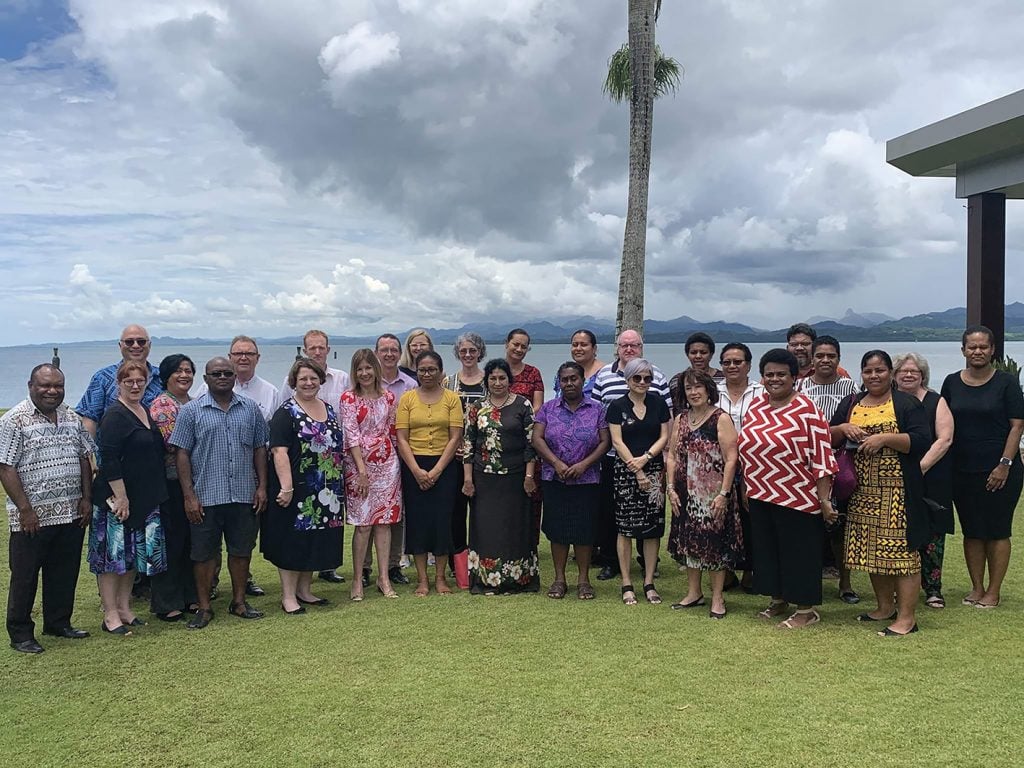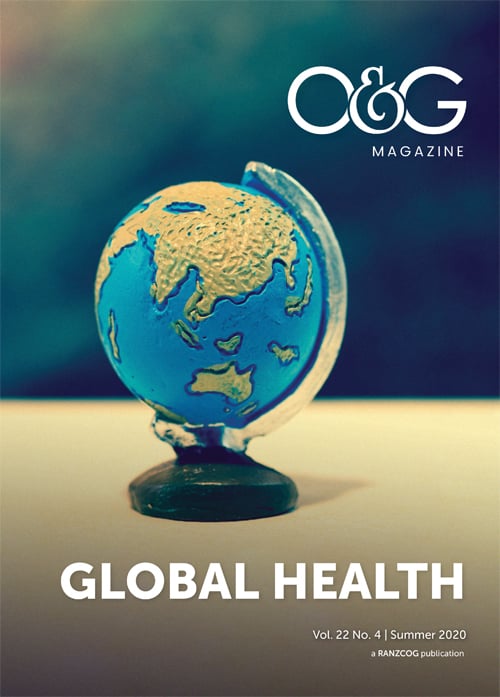In May 2018, the Director-General of the World Health Organization (WHO) announced a global call to action towards the elimination of cervical cancer as a public health problem, defined as being achieved when the incidence is below 4 per 100,000 women-years. This is an ambitious aim; rates in Pacific Island Countries currently range between 10–30 per 100,000 women-years. The highest incidence is in the most populace country, Papua New Guinea, where the incidence is even higher amongst those infected with HIV.
Progress toward a consensus on tackling the incidence of cervical cancer in the Pacific has been greatly accelerated by the announcement in 2019 of the WHO ‘Draft Global Strategy towards the elimination of cervical cancer as a public health problem.’1 This strategy is based on three principles, which WHO aims to be met globally by 2030:
- 90% of girls fully vaccinated by age 15
- 70% of women screened with a high-precision test at 35 and 45 years of age
- 90% of women with cervical pre-cancer or invasive cancer receive treatment
This WHO draft guideline is predicted to achieve elimination of cervical cancer as a public health problem by 2090.
Implementing this guideline across the Pacific will be problematic. There is currently no organised program for vaccination other than sporadic projects, and the cost of human papillomavirus (HPV) vaccine varies markedly across the region, from US$30–150. This cost is prohibitive to low-income countries, but UNICEF has committed to supplying vaccines across the Pacific for five years from 2021.
Screening with cytology has been difficult, as samples generally must go offshore for processing, leading to significant delays. Patients with abnormal cytology have to be located at a later date. Colposcopy is not available in most Pacific Islands, and generally leads to further delays since histological specimens take even longer to process than cytology. Delays of three months are usual. Visual inspection with acetic acid (VIA) was touted as a cheap and effective alternative, although VIA positivity has been shown to be associated with the presence of HPV 16 but not other HR-HPV types.2
Primary screening with HPV testing is more promising, not only because of its greater accuracy, but it is far easier to conduct in remote settings. This test can be performed using a portable, battery-operated GeneExpert (Cepheid) system, enabling on-the-spot analysis of samples with results available within an hour. These units are often already available in many Pacific Countries where they are used to test for TB, HIV and other infectious diseases. It utilises a Polymerase Chain Reaction (PCR) test, the ‘high-precision’ test recommended by WHO.
Not only does this have a high specificity and sensitivity for the detection of HR-HPV, but has been shown to be as accurate when performed on self-collected samples as clinician-collected3 eliminating the need for a speculum examination, a major barrier to screening in Pacific Islands.
The advent of thermal ablation for treatment of screen-positive women has made treatment easier since it is portable and requires neither mains electricity nor a gas supply.4 5
A ‘screen-and-treat’ approach, whereby women who screen positive for high-oncogenic-risk HPV receive immediate treatment with a modality such as thermal ablation of the transformation zone, may seem misguided to those of us in high-income countries due to the risks of preterm labour after treatment for cervical disease. It is true that an unknown number of women will be over-treated, but the older screening age and use of an ablative technique for treatment in most instances will minimise this risk. ‘Screen-and-treat’ is felt to be the most feasible approach to ensure that screen-positive women receive treatment.
In order to address the specific concerns related to implementing the WHO Draft Guidelines in Pacific Island Countries, a meeting of interested parties was held in Suva from 5–6 December 2019. It was organised and facilitated by the Pacific Society for Reproductive Health (PSRH).
Despite challenges with organisation and limitations on travel due to the measles epidemic in Samoa, the meeting was well attended with delegates from Papua New Guinea, Vanuatu, Solomon Islands, Kiribati, Federated States of Micronesia, Fiji and Samoa. A number of organistions were represented: PSRH, Papua New Guinea Obstetrics and Gynaecology Society, Fiji Obstetrics and Gynaecology Society, Papua New Guinea Institute of Medical Research, Cervical Cancer Prevention in the Pacific, The Pacific Community (SPC), VCS Foundation, RANZCOG, Kirby Institute at the University of New South Wales, Family Planning Australia, Australian Cervical Cancer Foundation, Fiji Cancer Society, Fiji National University, University of Otago, National University of Samoa and Victoria University. Also present were representatives of the United Nations Population Fund and the United Nations Children’s Fund.
Presentations were heard from key speakers, and each country representative had the opportunity to describe the current state of vaccination, screening and treatment in their country, along with recognised barriers to moving forward.
It was agreed that any approach should involve vaccination against HPV, screening for, and treatment of, cervical pre-malignancy, and treatment of established disease. Some modification of the WHO draft guideline was felt appropriate to enable small nations to screen in multiple-age cohorts.
The meeting agreed to the following principles:
- Support for the global target to achieve elimination of cervical cancer as a public health problem, noting the current high burden of cervical cancer in the Pacific and the current lack of adequate vaccination, screening and treatment.
- In line with the WHO draft targets for 2030, in the Pacific the targets are:
- 90% of girls are fully vaccinated against HPV by 15 years of age
- 70% of women have had an HPV screening test between 30–39 years of age and a second HPV test between 40–49 years of age (Tests to be 10 years apart)
- 90% of women identified with cervical pre-cancer and cancer have received appropriate treatment and care
- Support for the principles of equity in striving for the elimination of cervical cancer in the Pacific so that no woman or community is left behind
- Support for the principle of meaningful collaboration between Pacific Island nations in planning, procurement and knowledge sharing
The necessity to establish an adequate registry of vaccination, screening and treatment for the prevention of cervical cancer, with potential linkage to a cancer registry, was also recognised.
There was also commitment to urging Pacific Island governments to include HPV vaccination in existing immunisation schedules and to establish a treatment centre for cervical cancer, including radiotherapy, to act as a referral hub within the Pacific.
Of course, none of this will be possible without the appropriate political will and funding, but this consensus will go a long way to highlighting to communities and governments the urgent need to implement the required initiatives to save Pacific women and their families from needless suffering and premature death from this preventable disease.

Pacific delegates and experts on meeting, Suva, Fiji, 5–6 December 2019. Regional Cervical Cancer Prevention and Control.
References
- WHO. Draft Global Strategy towards eliminating cervical cancer as a public health problem. 2020. Available from: www.who.int/publications/m/item/draft-global-strategy-towards-eliminating-cervical-cancer-as-a-public-health-problem
- Vallely AJ, Toliman PJ, Ryan C, et al. Association between visual inspection of the cervix with acetic acid examination and high-risk human papillomavirus infection, Chlamydia trachomatis, Neisseria gonorrhoeae and Trichomonas vaginalis in Papua New Guinea. ANZJOG. 2018;58;576-81.
- Arbyn M, Smith SB, Temin S, et al. Detecting cervical precancer and reaching underscreened women by using HPV testing on self samples: updated mete-analyses. BMJ. 2018;363:k4823. Available from: doi.org/10.1136/bmj.k4823
- Randall CT, Sauvaget C, Muwonge R, et al. Worthy of further consideration: An updated meta-analysis to address the feasibility, acceptability, safety and efficacy of thermal ablation in the treatment of cervical cancer precursor lesions. Prev Med. 2018;118:81-9. Available from: doi.org/10.1016/j.ypmed.2018.10.006
- Vallely A, Toliman P. Health service delivery models for scaling use of point-of-care HPV ‘test and treat’ strategies in high-burden, low income settings. J Virus Erad. 2019;5(suppl 1):1-3.






Leave a Reply